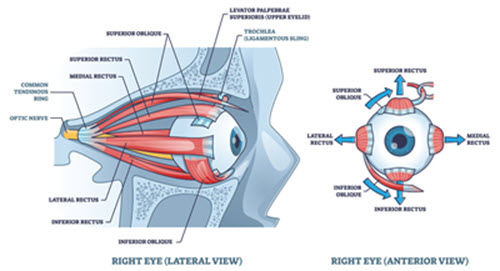Keep reporting rules straight or risk losing rightful reimbursement.
Strabismus surgery can involve any combination of 12 extraocular muscles. Incorrectly identifying just one of those muscles can lead you to the wrong code. You must also be on top of bilateral rules, diagnoses, and separate procedures; any misstep can take more than $600 out of your practice’s pocket.
If you find yourself stumped by the ins and outs of strabismus coding, help is here. Let these three handy hints guide you through the snags, so you’ll be well-equipped to submit airtight claims for eye muscle surgery the next time one comes your way.

Hint 1: Draw on Your Knowledge of Eye Anatomy
A little knowledge of ocular anatomy goes a long way toward understanding strabismus-correcting procedures. Because the codes you report depend on the extraocular muscle(s) involved, you must be able to understand op note documentation and translate what your ophthalmologist has reported doing during surgery into the right code.
Each eye has six extraocular muscles that control movements of the eye and determine the eyeball alignment, or in some cases, misalignment. They work together in pairs — complementary (or yoke) muscles pull the eyes in the same direction, and opposite muscles (or antagonists) pull the eyes in opposite directions. Strabismus surgery is done to loosen or tighten the eye muscle(s), depending on the affliction, which realigns the eyes into the correct position.
CPT® distinguishes the strabismus surgery codes (67311-67318) by whether the procedure involves horizontal muscles, vertical muscles, or the superior oblique (SO) muscle.
Horizontal: The medial rectus (MR), or nose-side, muscles move the eyes inwardly; when working simultaneously, they converge, or cross, the eyes. The lateral rectus (LR), or temple-side, muscles move the eyes outwardly; when they work simultaneously, they diverge or splay apart the eyes. If the ophthalmologist recesses (weakens) or resects (strengthens) these muscles, report 67311 (Strabismus surgery, recession or resection procedure; 1 horizontal muscle) or 67312 (... 2 horizontal muscles), depending on the number of muscles operated on.
Vertical: The vertical rectus muscles — superior rectus (SR) moving the eyes upwardly and inferior rectus (IR) moving them downwardly — are teamed like the horizontal recti. If the ophthalmologist recesses or resects these muscles, report 67314 (Strabismus surgery, recession or resection procedure; 1 vertical muscle (excluding superior oblique)) or 67316 (... 2 or more vertical muscles (excluding superior oblique)), depending on the number of muscles adjusted.
CPT® also considers the inferior oblique (IO) muscle — but not the superior oblique muscle — a vertical muscle. So, you’ll report 67314-67316 for recession or resection of the inferior oblique muscles.
Superior oblique: The SO muscle functions to move the eye down and out (depression and lateral rotation) and intort the eye (internal rotation toward the nose). Report 67318 (Strabismus surgery, any procedure, superior oblique muscle) for procedures performed on the SO muscle.
Hint 2: Consider Strabismus Surgery Unilateral
The strabismus surgery codes 67311-67318 are inherently unilateral, describing procedures performed on one eye only. When codes mention more than one muscle (e.g., 67312), CPT® is implying that those muscles are on the same eye. Therefore, if the surgeon resects one horizontal muscle on each eye, 67312 would not be correct. In that scenario, report 67311 as a bilateral procedure.
Payer preferences vary on the usage of laterality modifiers 50 (Bilateral procedure), LT (Left side), and RT (Right side). Most Medicare carrier payers prefer that you list the code once with the bilateral modifier appended (e.g., 67311-50), says Heather Corcoran, coding manager at CGH Billing Services in Louisville, Kentucky. Other payers may require reporting bilateral procedures on two lines, for example, 67311-LT for the left eye and 67311-RT for the right.
Medicare usually reimburses for 67311-50 based on 150 percent of the fee schedule amount for a single code. The 2023 fee schedule assigns 13.39 national unadjusted facility RVUs to 67311, which yields $453.75 when multiplied by the 33.8872 conversion factor. Code 67311-50 should reimburse $680.62, 150 percent of $453.75.
However, if the ophthalmologist recesses both the LR and MR muscles of the left eye, you will report it as two (unilateral) muscles, not a bilateral procedure. This is a case in which 67312 is appropriate. Medicare allows $661.48 for this procedure (19.52 RVUs x 33.8872).
Hidden trap: The same rules apply to the vertical muscle codes, although the wording “two or more vertical muscles” in the definition of 67316 may lead you to think it’s a bilateral code since there are technically only two vertical muscles in one eye.
Remember, however, that CPT® considers the IO muscle a vertical muscle for coding purposes — so the ophthalmologist could resect “two or more vertical muscles” in one eye if they operate on the SR, IR, and IO muscles.
Watch out: The bilateral status is different for the six strabismus add-on codes. CMS assigns them a bilateral status of “0,” meaning that the 150 percent payment adjustment usually applied to multiple or bilateral procedures does not apply to these add-on codes.
When the strabismus surgery involves additional intra-service work beyond that of the primary procedure, look to the following six add-on codes to report the extra work:
“These codes cause some confusion, both in terms of when to use them and how they are paid.,” says Mary Pat Johnson, CPC, CPMA, COMT, COE, senior consultant with Corcoran Consulting Group. Note the descriptor instructs you to only report the add-on codes in conjunction with the primary eye muscle procedure codes.
Only use codes +67320-+67334 in conjunction with 67311-67318. And only report +67335 and +67340 with codes 67311-67344, according to Johnson. Also, “do not report modifiers 50 or 51 [Multiple procedures] with an add-on code. Set a charge high enough to capture the full allowed amount for these codes,” she adds.


Hint 3: Remember, MRIs Aren’t Always Covered for Strabismus Dx
Carriers’ policies vary on coverage for magnetic resonance imaging (MRI). Most Medicare carriers are of the opinion that not all patients with the diagnosis of strabismus (H49- through H50-) require an MRI. Three conditions for which many payers will cover MRI are paralytic strabismus (H49-), mechanical strabismus (H50.6-), and Duane’s syndrome (H50.8-).
If your ophthalmologist orders imaging, pay close attention to the MRI code descriptors when reporting the service. CPT® organizes the MRI codes according to the area of the body examined. Strabismus-related MRI codes include:
